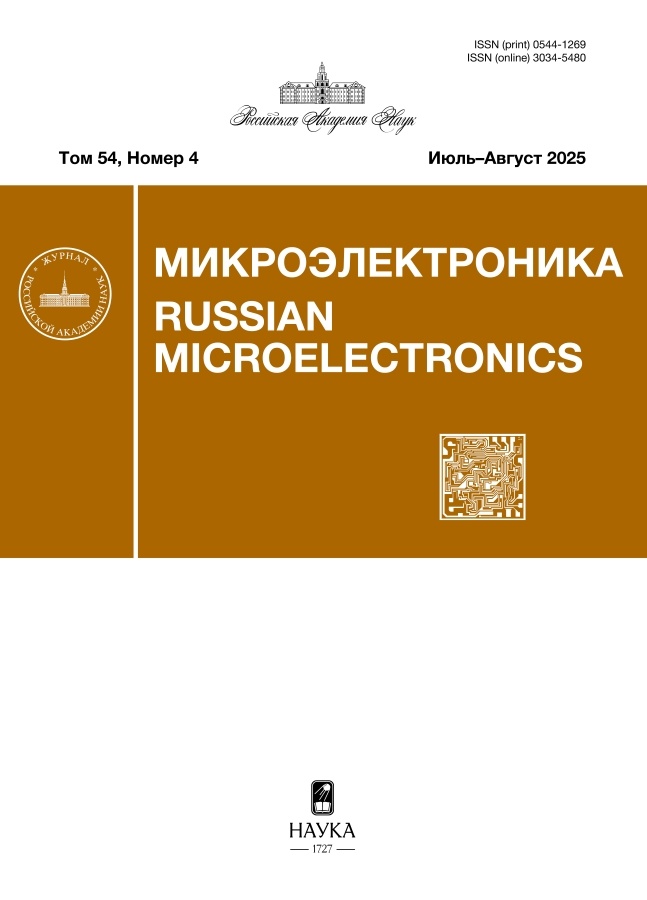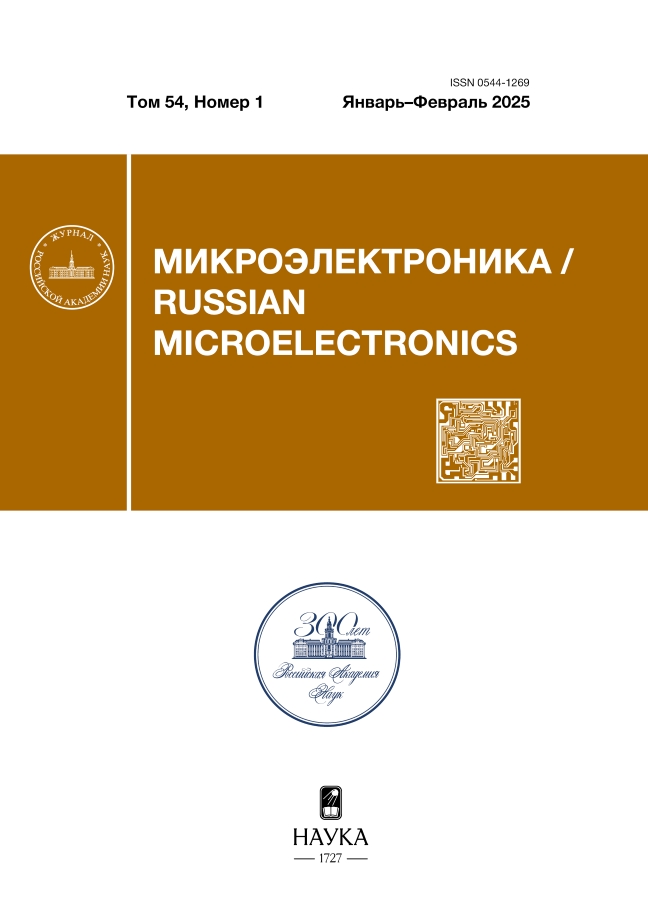Исследование режимов осаждения пленок Cu2O методом ВЧ магнетронного распыления для применения в структурах солнечных элементов
- Авторы: Саенко А.В.1, Жейц В.В.1, Вакулов З.Е.1, Смирнов В.А.1
-
Учреждения:
- Южный федеральный университет
- Выпуск: Том 54, № 1 (2025)
- Страницы: 64-75
- Раздел: ТЕХНОЛОГИИ
- URL: https://edgccjournal.org/0544-1269/article/view/685020
- DOI: https://doi.org/10.31857/S0544126925010071
- EDN: https://elibrary.ru/GHZFLY
- ID: 685020
Цитировать
Полный текст
Аннотация
Проведено осаждение пленок Cu2O методом высокочастотного (ВЧ) магнетронного распыления в бескислородной среде при комнатной температуре. Исследовано влияние мощности и давления в камере на скорость осаждения, структурные и оптические свойства пленок Cu2O. Показано, что зависимость скорости осаждения пленок Cu2O от мощности распыления имеет практически линейный характер и незначительно возрастает при увеличении давления аргона в камере. Получено, что все пленки Cu2O имеют преимущественно нанокристаллическую структуру, состоящую из столбчатых зерен, средний размер которых возрастает от 10 до 30 нм при увеличении мощности распыления от 25 до 100 Вт и давления в камере от 3·10–3 до 7·10–3 мбар. При этом пленки Cu2O имеют относительно гладкую поверхность со средней шероховатостью в диапазоне от 4.5 до 5.9 нм. Установлено, что для осаждения пленок Cu2O с наибольшим размером зерен и низкой шероховатостью поверхности оптимальной является мощность распыления 75 Вт и давление в камере 5·10–3 мбар. Показано, что при данном режиме магнетронного напыления пленка Cu2O имеет два основных дифракционных пика, которым соответствуют ориентации кристаллических плоскостей (111) и (200) для кубической фазы Cu2O, а также высокое оптическое поглощение до порядка 600 нм и ширину запрещенной зоны 2.18 эВ. Проведено изготовление макетов солнечных элементов на основе гетероперехода ZnO/Cu2O методом магнетронного распыления при комнатной температуре и исследованы их вольт-амперные характеристики. Полученные результаты могут быть использованы при разработке структур и технологических процессов формирования солнечных элементов на стеклянной и гибкой подложках с помощью метода магнетронного распыления.
Полный текст
Об авторах
А. В. Саенко
Южный федеральный университет
Автор, ответственный за переписку.
Email: avsaenko@sfedu.ru
Россия, Таганрог
В. В. Жейц
Южный федеральный университет
Email: avsaenko@sfedu.ru
Россия, Таганрог
З. Е. Вакулов
Южный федеральный университет
Email: avsaenko@sfedu.ru
Россия, Таганрог
В. А. Смирнов
Южный федеральный университет
Email: avsaenko@sfedu.ru
Россия, Таганрог
Список литературы
- Lakshmanan A., Zachariah C. Alex, Meher S. R. Recent advances in cuprous oxide thin film based photovoltaics // Materials Today Sustainability. 2022. V. 20. P. 100244. https://doi.org/10.1016/j.mtsust.2022.100244
- Saenko A.V., Bilyk G.E., Smirnov V.A. Study of the Photovoltaic Parameters of Inorganic Solar Cells Based on and CuO // Russian Microelectronics. 2024. V. 53(4). P. 319–328. https://doi.org/10.1134/S1063739724600407
- Zhigang Zang, Wensi Cai, Yong Zhou. Metal Oxide Semiconductors for Solar Cells // Metal Oxide Semiconductors: Synthesis, Properties, and Devices. 2023. Chapter 6. P. 171–210. https://doi.org/10.1002/9783527842551.ch6
- Subhash Chander, Surya Kant Tripathi. Recent advancement in efficient metal oxide-based flexible perovskite solar cells: a short review // Materials Advances. 2022. V. 3. P. 7198–7211. https://doi.org/10.1039/D2MA00700B
- Sinuo Chen, Lichun Wang, Chunlan Zhou, Jinli Yang. A review of solar cell // Journal of Renewable and Sustainable Energy. 2023. V. 15. P. 062701. https://doi.org/10.1063/5.0167383
- Sven Ruhle, Assaf Y. Anderson, Hannah-Noa Barad, Benjamin Kupfer, Yaniv Bouhadana, Eli Rosh-Hodesh, Arie Zaban. All-Oxide Photovoltaics // Journal of Physical Chemistry Letters. 2012. V. 3. P. 3755–3764. https://doi.org/10.1021/jz3017039
- Amador Perez-Tomas. Functional Oxides for Photoneuromorphic Engineering: Toward a Solar Brain // Advanced Materials Interfaces. 2019. V. 6. P. 1900471. https://doi.org/10.1002/admi.201900471
- Saenko A.V., Bilyk G.E., Malyukov S.P. Research of the photoelectric parameters of ZnO/ heterojunction solar cells // St. Petersburg State Polytechnical University Journal: Physics and Mathematics. 2023. V. 16(31). P. 221–226. https://doi.org/10.18721/JPM.163.139
- Amador Perez-Tomas, Alba Mingorance, David Tanenbaum, Monica Lira-Cantu. Metal Oxides in Photovoltaics: All-Oxide, Ferroic, and Perovskite Solar Cells // The Future of Semiconductor Oxides in Next-Generation Solar Cells. 2018. V. 8. P. 267–356. https://doi.org/10.1016/B978-0-12-811165-9.00008-9
- Lakshmanan A., Zachariah C. Alex, Meher S.R. thin films grown by magnetron sputtering as solar cell absorber layers // Materials Science in Semiconductor Processing. 2022. V. 148. P. 106818. https://doi.org/10.1016/j.mssp.2022.106818
- Kudryashov D.A., Gudovskikh A.S., Babichev A.V., Filimonov A.V., Mozharov A.M., Agekyan V.F., Borisov E.V., Serov A.Yu., Filosofov N.G. Nanoscale Films: Radio-Frequency Magnetron Sputtering and Structural and Optical Studies // Semiconductors. 2017. V. 51(1). P. 110–114. https://doi.org/10.1134/S1063782617010110
- Al-Kuhaili M.F. Characterization of copper oxide thin films deposited by the thermal evaporation of cuprous oxide () // Vacuum. 2008. V. 82. P. 623–629. https://doi.org/10.1016/j.vacuum.2007.10.004
- Binghao Wang, Zhiqiang Chen, Feng Zhao. Heterojunction Solar Cell with Photovoltaic Properties Enhanced by a Ti Buffer Layer // Sustainability. 2023. V. 15. P. 10876. https://doi.org/10.3390/su151410876
- FeiFan Yang, WenBo Peng, YiJian Zhou, Rong Li, GuoJiao Xiang, JinMing Zhang YueLiu, JiaHui Zhang, Yang Zhao, Hui Wang. Thermal optimization of defected photon-absorbing layer and the steady p-/n-Si photovoltaic application // Vacuum. 2022. V. 198. P. 110876. https://doi.org/10.1016/j.vacuum.2022.110876
- Jun-A Kim, Jung-Hwan Park, Sang-Geon Park, Chang-Sik Son, Young-Guk Son, Dong-Hyun Hwang. Effect of Substrate Temperature on Variations in the Structural and Optical Properties of Thin Films Deposited via RF Magnetron Sputtering // Crystals. 2023. V. 13. P. 643. https://doi.org/10.3390/cryst13040643.
- Dolai S., Das S., Hussain S., Bhar R., Pal A.K.. Cuprous oxide () thin films prepared by reactive d. c. sputtering technique // Vacuum. 2017. V. 141. P. 296–306. http://doi.org/10.1016/j.vacuum.2017.04.033
- Qiang Yu, Huwei Zhao, Yuhong Zhao, Yue Zhao. The study of optical-electrical properties of ZnO/(CuO)/Si heterojunctions // Physica B: Condensed Matter. 2024. V. 690. P. 416253, https://doi.org/10.1016/j.physb.2024.416253
- Zhigang Zang. Efficiency enhancement of ZnO/ solar cells with well oriented and micrometer grain sized films // Applied Physics Letters. 2018. V. 112. P. 042106. https://doi.org/10.1063/1.5017002
- Shijeesh M.R., Jayaraj M.K. Low temperature fabrication of thin-film transistors and investigation on the origin of low field effect mobility // Journal of Applied Physics. 2018. V. 123. P. 161538. https://doi.org/10.1063/1.4991812
- Marwa Abd-Ellah, Joseph P. Thomas, Lei Zhang, Kam Tong Leung. Enhancement of solar cell performance of p-/n-ZnO-nanotube and nanorod heterojunction devices // Solar Energy Materials and Solar Cells. 2016. V. 152. P. 87–93. https://doi.org/10.1016/j.solmat.2016.03.022
- Teoman Ozdal, Hamide Kavak. Fabrication and characterization of ZnO/ heterostructures for solar cells applications // Superlattices and Microstructures. 2020. V. 146. P. 106679. https://doi.org/10.1016/j.spmi.2020.106679
- Grzegorz Wisz, Paulina Sawicka-Chudy, Maciej Sibinski, Dariusz Ploch, Mariusz Bester, Marian Cholewa, Janusz Wozny, Rostyslav Yavorskyi, Lyubomyr Nykyruy, Marta Ruszala. /CuO/ Photovoltaic Nanostructures Prepared by DC Reactive Magnetron Sputtering // Nanomaterials. 2022. V. 12. P. 1328. https://doi.org/10.3390/nano12081328
- Grzegorz Wisz, Paulina Sawicka-Chudy, Andrzej Wal, Maciej Sibinski, Piotr Potera, Rostyslaw Yavorsky, Lyubomyr Nykyruy, Dariusz Ploch, Mariusz Bester, Marian Cholewa, Olena M. Chernikova. Structure Defects and Photovoltaic Properties of : ZnO/CuO Solar Cells Prepared by Reactive DC Magnetron Sputtering // Aplied Sciences. 2023. V. 13. P. 3613. https://doi.org/10.3390/app13063613
- Abduev A.K., Akhmedov A.K., Asvarov A.S., Muslimov A.E., Kanevsky V.M. ZnO-based transparent conductive layers obtained by the magnetron sputtering of a composite cermet ZnO: Ga–Zn target: part 2 // Journal of Surface Investigation. X-Ray, Synchrotron and Neutron Techniques. 2021. V. 15. P. 121 127. https://doi.org/10.1134/S1027451021010031
- Saenko A.V., Vakulov Z.E., Klimin V.S., Bilyk G.E., Malyukov S.P. Effect of Magnetron Sputtering Power on ITO Film Deposition at Room Temperature // Russian Microelectronics. 2023. V. 52(4). P. 297 302. https://doi.org/10.1134/ S1063739723700452
- Laurentiu Fara, Irinela Chilibon, Ornulf Nordseth, Dan Craciunescu, Dan Savastru, Cristina Vasiliu, Laurentiu Baschir, Silvian Fara, Raj Kumar, Edouard Monakhov, James P. Connolly. Complex Investigation of High Efficiency and Reliable Heterojunction Solar Cell Based on an Improved Absorber Layer // Energies. 2020. V. 13. P. 4667. https://doi.org/10.3390/en13184667
- Saenko A.V., Bilyk G.E., Malyukov S.P. Modeling of an oxide solar cell based on a ZnO/ heterojunction // Applied Physics. 2023. № 4. P. 66–77. https://doi.org/10.51368/1996-0948-2023-4-66-77
- Bin Sun, Hao Chen, Kang Yan, Xiao-Dong Feng. Numerical investigation of the solar cell with double electron transport layers and a hole transport layer // Optical Materials. 2022. V. 131. P. 112642. https://doi.org/10.1016/j.optmat.2022.112642
Дополнительные файлы



















